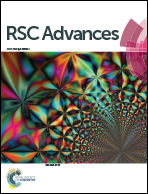Metal powder–pure water system for rational synthesis of metal oxide functional nanomaterials: a general, facile and green synthetic approach†
Abstract
Metal oxide (MO) nanomaterials have played a pivotal role in many fields. The general, facile and green approach for rational synthesis of MO nanomaterials is highly desirable. In this work, a simple approach via an ultrasonic-assisted preoxidation and a subsequent hydrothermal oxidation (UAPO–HO) of metal powders directly in pure water without using any other chemicals has been developed as a general synthetic route to prepare MO nanomaterials. Three representative MO nanomaterials (Mn3O4 nanorods, ZnO nanopellets, and Fe3O4 nanocubes) have been successfully synthesized by this UAPO–HO approach for the first time. The properties of the newly synthesized MO nanomaterials, such like Mn3O4 as an electrode material for supercapacitors, ZnO as an photocatalyst for degrading organic pollutants, and Fe3O4 as a magnetic catalyst for disposing antibiotics, are investigated, which demonstrate attractive performance in energy storage and environmental protection. The synthetic approach developed here has the significant advantages of being chemical-utility least, product-purity high, facile, green and mild, which offers a unique clue for synthesis of MO nanomaterials.


 Please wait while we load your content...
Please wait while we load your content...